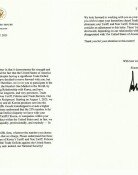How to Mark `Off Limits`
The oldest stone structure in human history, pyramid, is only 4,000 years old, and the oldest letter Sanskrit is some 7,000 years old. Then how could humans produce a mark that will last 10,000 years?
The U.S. Congress recently decided to build a landfill site for high-grade nuclear wastes near Mountain Uka in Nevada. The site will house high-grade wastes currently stored in private nuclear reactors throughout 31 states.
Nuclear wastes are divided into high, mid and low-grade depending on the degree of exposure to radiation, and there is no country for now capable of processing high-grade wastes thoroughly.
Damage caused by radiation is bound to last tens of thousands years. The Nuclear Regulation Committee in the U.S., therefore, has set a condition for the construction of the landfill site – the government must submit by year 2004 a plan to leave an enduring mark on the site so that descendants will not dig up nuclear wastes some 10,000 years later by chance.
When the landfill is completed, some 70,000 tons of high-grade nuclear wastes will be dumped into the place over 300 years and then be sealed permanently. The amount equals to dozens of atomic bombs that devastated Japan during the World War II.
For the last 20 years, a number of proposals have been made in relation to the nuclear landfill site. Some suggested that they could turn the color of trees in Mt. Uka into grisly blue through genetic engineering as a mark of danger, while others speaking about digging a huge ditch around the landfill site.
It would be better not to leave any mark so that people will not grow curious about what is inside, some pointed out. Another idea was that they could leave a mark saying precious germs are buried far away from the mountain to turn people`s attention from the site.
There is still no viable idea about building a mark that can last possible disastrous events such as a war, a seismic movement and a collision with a meteorite.
˝Whatever method they choose to use, that will be a mark for the greatest mistake of our generation, not for the greatest achievement,˝ said Joshua Abby, Director of Las Vegas Desert Space Foundation.
Seung-Jin Kim sarafina@donga.com





![[단독]尹 “들여보내지 말라니까”…경호본부장 “관저 2정문 뚫리면 소총들고 나가라”](https://dimg.donga.com/c/138/175/90/1/wps/NEWS/IMAGE/2025/07/07/131931090.1.jpg)

